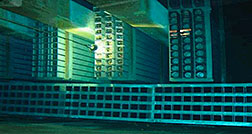- Number 401 |
- November 18, 2013
SRNL and partners explore coatings for next generation of nuclear fuels

SRNL and partners explore coatings for
next generation of nuclear fuels.
While fuels used in commercial reactors in the United States today are already extremely robust, there is always an interest in improving the state of the art.
And while advanced fuel development is not a new program, the events at the Fukushima Daiichi nuclear power station have led U.S. policymakers to reexamine current designs – can we do better?
DOE’s Savannah River National Laboratory (SRNL) is a partner with AREVA, the Universities of Wisconsin and Florida, the Electric Power Research Institute, TVA and Duke Power, on a project to identify, develop and begin testing new fuel concepts. The program is under the auspices of DOE’s Office of Nuclear Energy. The overall goal represents a materials science challenge – to identify advanced materials and / or fuel cladding that would improve performance and safety, both during reactor service and during long-term fuel storage.
The shorthand name for the program is accident tolerant fuels.
Fuels with enhanced accident tolerance are those that, in comparison with the standard UO2 – Zircaloy system, can tolerate loss of active cooling in the core for a considerably longer time period (depending on the system and accident scenario) while maintaining or improving the fuel performance during normal operations.
“There are a couple of different avenues,” says SRNL researcher Thad Adams. “One would be to increase the thermal conductivity of the fuel that’s inside the rod and drive the overall temperature down. The other is to put some kind of coating on the outside of the zircaloy tube so that the water and the zirc would not react.”
The latter way – involving advancements in coating – is the focus of the SRNL activity. The team partners will develop and test MAX phase materials for suitability as a coating system for fuel for the present generation of nuclear reactors or for next generation reactor designs.
MAX phase materials are a relatively new class of ternary metal carbides or nitrides that are fully machinable. These ceramic compounds have a unique set of properties, including good thermal conductivity, elevated temperature ductility and fracture toughness and are “weldable.” In addition, they have the typical ceramic characteristic of high temperature mechanical and chemical stability, and high resistance to chemical attack.
The plan is for compounds from the MAX phase class of carbides to be selected and spray-applied to zircaloy substrates / claddings to yield an improved cladding compatible with the existing fleet of Light Water Reactor fuel, and highly resistant to high water temperature and steam conditions.
In addition to the research with AREVA, SRNL has initiated a separate LDRD project to “tweak” some of the commercially available MAX phase materials, in hopes of generating a separate, improved class for the same kind of coatings.
The program goal is to have a lead test assembly by 2020.[Will Callicott, 803.725.3786,
will.callicott@srnl.doe.gov]
